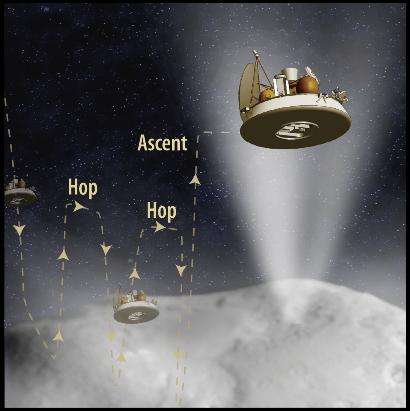Credit: NASA/GSFC/University of Maryland
(PhysOrg.com) -- A University of Maryland-led mission proposal know as Comet Hopper has been chosen to compete for final selection as a new planetary mission in NASA's Discovery Program. The team will receive $3 million to further develop its mission proposal concept.
A panel of NASA and other scientists and engineers reviewed 28 submissions and selected Comet Hopper and two other proposals for further study. After concept studies are reviewed in 2012, NASA will select one mission to continue development efforts leading up to launch in 2016. The selected mission will be cost-capped at $425 million, not including launch vehicle funding.
University of Maryland Astronomer Jessica Sunshine is the principal investigator (PI) for Comet Hopper. Additional Maryland scientists on the team include Deputy PI Michael A'Hearn, who led NASA's Deep Impact and EPOXI comet missions. The Comet Hopper mission would be managed by NASA Goddard Space Flight Center in Greenbelt, Md. Other partners include Lockheed Martin, KinetX, the Johns Hopkins University Applied Physics Laboratory, University of Bern, Jet Propulsion Laboratory and Discovery Communications.
"We've had some amazing cometary flybys but they have given us only snapshots of one point in time of what a comet is like," said Sunshine. "Comets are exciting because they are dynamic, changing throughout their orbits. With this new mission, we will start out with a comet that is in the cold, outer reaches of its orbit and watch its activity come alive as it moves closer and closer to the sun."
The Comet Hopper mission would study the evolution of 46P/Wirtanen by landing on the comet multiple times and observing its changes as it interacts with the sun. Comet Hopper would observe the comet by making detailed in situ measurements from various locations on the surface and in the innermost coma as the comet moves through its orbit. The innermost coma is the atmosphere of the comet just off the surface of the nucleus where outgassing and jets originate. "We would extensively explore the surface of a comet, this is something that has never been done before," said Joe Nuth, Comet Hopper project scientist at NASA Goddard. "We know that there are volatiles (molecules that easily evaporate at normal temperatures) inside a comet. We would go to places that are relatively flat and are likely hiding volatiles. Comet Hopper could be called a reconnaissance mission for an upcoming Comet Nucleus Sample Return mission, which has been deemed a high priority development effort by the Decadal Survey."
The spacecraft carries complementary instruments that would study the physical and chemical structure of the comet's nucleus and innermost coma. The suite of instruments includes both remote and in situ capabilities. Among the instruments are a Mapping Camera, an IR Spectrometer, a Mass Spectrometer, Panoramic Cameras, and a Thermal Probe.
The two planetary missions against which Comet Hopper will compete for final NASA selection as a Discovery Program planetary mission are:
-- Geophysical Monitoring Station (GEMS) would study the structure and composition of the interior of Mars and advance understanding of the formation and evolution of terrestrial planets. Bruce Banerdt of NASA's Jet Propulsion Laboratory (JPL) in Pasadena, Calif., is principal investigator. JPL would manage the project.
-- Titan Mare Explorer (TiME) would provide the first direct exploration of an ocean environment beyond Earth by landing in, and floating on, a large methane-ethane sea on Saturn's moon Titan. Ellen Stofan of Proxemy Research Inc. in Gaithersburg, Md., is principal investigator. Johns Hopkins University's Applied Physics Laboratory in Laurel, Md., would manage the project.
Provided by University of Maryland























